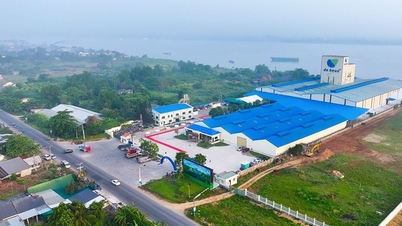Pricing strategy can bring both competitive advantages and disadvantages, determining the success or failure of a business.
 |
| Product pricing strategy plays a key role in ensuring the establishment and development of synchronous institutions and structures for the financial market. (Source: Shutterstock) |
Financial management is a prerequisite for businesses to exist, maintain and develop because profit or economy in general is the core goal that most businesses strive towards. In that process, product price is the basic driving force to promote production, business and trade development. Therefore, businesses always prioritize building and developing strategies to determine the price of their products.
The importance of pricing strategy
Prices can be set to maximize profits and used to protect existing markets from new entrants. Pricing strategies can provide both competitive advantages and disadvantages to a company and often determine the success or failure of a business.
Marginal cost of production and marginal revenue are economic measures used to determine the quantity of output and price per unit that will maximize profits. In pricing strategy, the business must seek to earn the most profit possible through the analysis of revenue and marginal cost of production.
Economist Adam Smith asserted that the “invisible hand” of the market relies on price fluctuations to transfer resources to where they are needed. In particular, commodity prices play an important role in determining the efficient allocation of resources in the market system.
Prices act as signals of shortages and surpluses, helping businesses and consumers respond to changing market conditions. Allocative efficiency is said to occur when the marginal benefit from a good equals its marginal cost. This allocative efficiency will be achieved at the level of output where market price = marginal cost. In other words, when the supply curve meets the demand curve.
If a good is scarce, its price tends to rise, reducing demand and encouraging firms to try to increase supply, and conversely, if a good is in surplus, its price tends to fall, encouraging buying and causing firms to try to reduce supply. In addition, prices also help reallocate resources from goods that are less in demand to goods that are more valued by people.
The reality of the agricultural sector shows that when there is a bad harvest, the output of agricultural products decreases (the supply curve of goods shifts down, leading to an increase in the price of goods (gaining value). In the short term, demand is not elastic with price, so demand only decreases slightly. The picture will change in the opposite direction when there is a good harvest, leading to an increase in the supply of agricultural products, causing the price of products to decrease (lose value) if businesses do not have solutions to diversify and develop more market share.
However, in the long run, the market does not stand still. If prices rise, the profits of producing agricultural products increase and then businesses can earn super profits because marginal revenue is greater than marginal cost.
This higher price acts as an incentive for businesses to try to increase production. Therefore, over time, higher prices lead to more investment in the industry and supply can increase again to a new level in the long run at a more suitable price for consumers.
Consumer behavior
Consumers play a role as one of the three subjects of the market economy and have a strong impact on product prices. In turn, prices also affect consumer behavior. The interaction between consumers and the current high oil prices due to the supply chain crisis can be illustrated, causing a decrease in output. In the short run, the demand curve is very price inelastic.
However, along with the prolonged economic crisis and the gradual depletion of world resources, the increasing price of Brent crude oil will certainly affect consumer behavior. They will look for more fuel-efficient engines such as buying motorbikes, cars with better fuel efficiency or using alternative vehicles such as bicycles, public transport, etc., leading to a gradual decrease in the demand for fossil fuels in the long term.
This could be a good opportunity for the green energy industry, and it is also a time for developing countries to take advantage of high technology to promote the strategy of competitive advantage in terms of economies of scale in the strong restructuring of transport infrastructure towards public transport such as buses, trains and high-speed rail. In the long term, along with increased investment in alternative energy and the demand for fossil fuels with continued decline in output, leading to a decrease in gasoline prices according to market rules.
Notes on strategic planning
In theory, it can be seen that the increase in commodity prices helps the economy to escape from dependence on traditional goods because prices will create signals for businesses and consumers to seek alternatives, promoting innovation and creativity. However, to further promote the role and function of prices in financial resource management, planning pricing strategies for products and services also needs to pay attention to further research in the following three areas:
Firstly, with the presence of international factors, commodity prices may not reflect the real social costs and social benefits, especially for essential goods and services. Determining environmental impact costs and labor wages leads to the creation of an attractive short-term investment business environment, but contains many potential long-term risks for the sustainability of human resources and the living environment of the country. Therefore, this can cause under- or over-consumption leading to inadequacies in the operation of the market economy and the import and export of goods and services with countries with more developed market economies.
Second is inequality. Prices help resources shift to areas with the greatest need, but can lead to unfair allocation, resource depletion and inequality in the environmental and social fields. Especially in an economy characterized by land resources owned by the entire people, determining prices in land use rights business depends heavily on planning work and legal regulations related to land use purposes.
Furthermore, it should be noted that the real estate and financial markets are closely symbiotically related in the market economy, so it is necessary to manage prices well in these two areas to avoid crises. In addition, in times of natural disasters, armed conflicts, epidemics, etc., the scarcity of essential goods and services in the market leads to high prices, affecting people's needs. In this scenario, there needs to be a plan for equitable distribution rather than distribution based on profits and escalating market prices.
Third is monopoly and group interests. In the situation of monopoly and group interests as well as the non-transparent competitive environment in the fields of real estate, equitization of state-owned enterprises, public investment, bidding, tariffs, stock market, cross-ownership of banks and currencies... higher or lower prices may not reflect a shortage or surplus of goods but reflect monopoly, insider and dominated power. This leads to inefficient allocation due to speculative motives, corruption... distorting the operation of the market and the economy stagnating.
It can be said that product pricing strategy plays a key role in ensuring the construction and development of institutions and synchronous structures for the financial market. Financial capital management must first of all be objectively and accurately priced to create liquidity in order to exploit and promote optimal efficiency for all other resources such as production capital, human, social and natural resources. This helps promote positive innovation and creativity of people as well as mobilize all capital resources for sustainable socio-economic development.
Source: https://baoquocte.vn/quan-tri-gia-trong-nen-kinh-te-275667.html





![[Photo] Closing of the 14th Conference of the 13th Party Central Committee](https://vphoto.vietnam.vn/thumb/1200x675/vietnam/resource/IMAGE/2025/11/06/1762404919012_a1-bnd-5975-5183-jpg.webp)

![[Photo] Prime Minister Pham Minh Chinh receives the delegation of the Semiconductor Manufacturing International (SEMI)](https://vphoto.vietnam.vn/thumb/1200x675/vietnam/resource/IMAGE/2025/11/06/1762434628831_dsc-0219-jpg.webp)









































































































Comment (0)